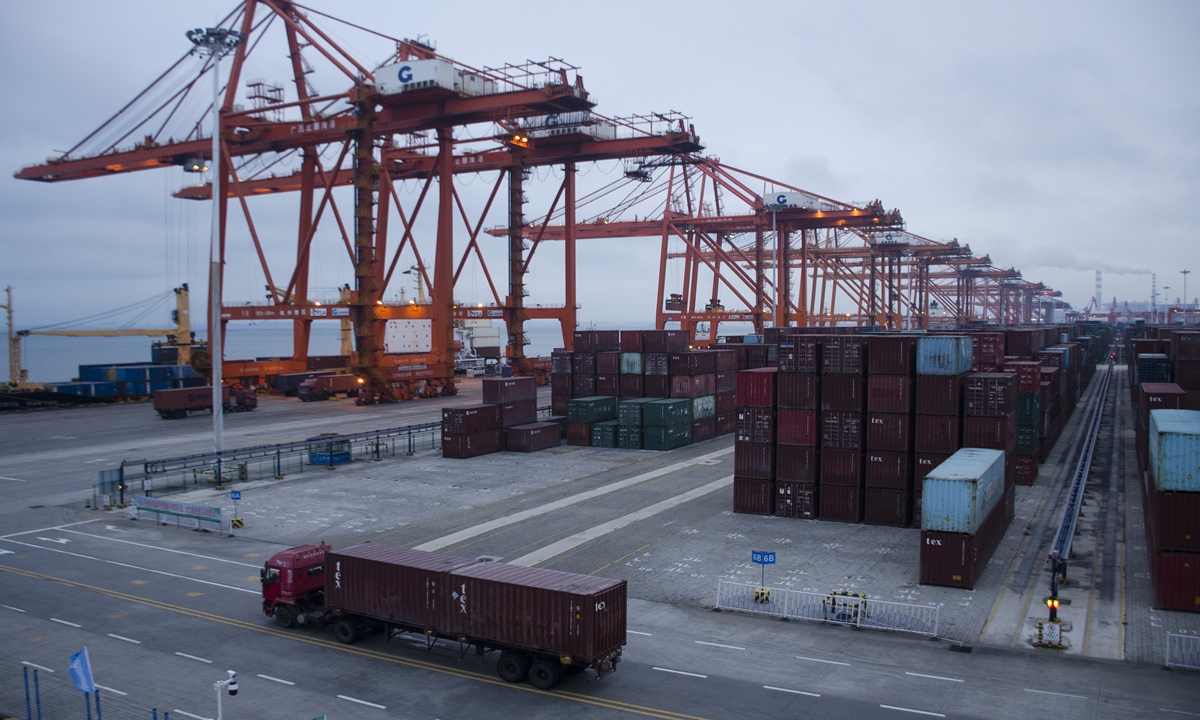
Photo taken on January 10, 2022 shows the container terminal of Qinzhou Port in Qinzhou, South China's Guangxi Zhuang Autonomous Region. Qinzhou vowed to build itself into a China-ASEAN trade and cooperation center and to be open to navigation to major ports in the world. Photo: VCG
Trade between China and the US expanded by 11.7 percent in the first six months of 2022 to 2.47 trillion yuan ($367 billion), outpacing China's trade growth with its other two top trading partners - the EU and ASEAN, data from Chinese Customs showed on Wednesday.
The expansion in China-US trade despite persistent efforts by the US government to crack down on Chinese products and businesses further highlighted the failure of the US' trade war and decoupling attempt as well as the need for Washington to shift focus toward improving bilateral cooperation amid a looming economic crisis in the US, analysts noted.
In the first half of the year, China's exports to the US surged 14.8 percent to 1.88 trillion yuan despite lingering tariff hikes and other restrictions, while imports of US goods edged up 2.6 percent to 586.6 billion yuan, according to data from the General Administration of Customs (GAC) on Wednesday.
The surge in Chinese exports to the US was within expectations, as the US' consumption demand amid an economic recovery has outstripped its supply chain's capacity, Tian Yun, a veteran macroeconomic analyst, told the Global Times on Wednesday, noting that the impact of COVID-19 on US labor and supply chains as well as poor US domestic governance has increased the demand for Chinese imports.
In June, China's trade surplus with the US widened by 26 percent from a year earlier to $41.4 billion in dollar terms, according to Global Times calculations based on GAC data.
The continued expansion of the US deficit with China shows that it is wrong for the US to use tariffs as a weapon to reduce its trade deficit, Gao Lingyun, an expert at the Chinese Academy of Social Sciences in Beijing, told the Global Times on Wednesday.
Electromechanical and audio-visual equipment, and associated parts and accessories, was the most traded category between China and the US in the first five months, according to Chinese Customs data. Detailed figures for June have not been released yet.
In the first five months, China exported electromechanical equipment worth 635 billion yuan to the US. This was followed by exports of textile products, which totaled 132 billion yuan.
China imported 101 billion yuan worth of electromechanical equipment from the US. This was followed by oilseeds and feed, which totaled 68 billion yuan, and mining products, which hit 65 billion yuan.
The figures show that the trade relationship is highly complementary, and the lingering impact of the additional tariffs cannot prevent trade growth between the two countries, Gao said.
The surge of US-China trade comes as the US is faced with the risk of recession and mounting pressure from inflation. The US consumer price index rose 9.1 percent in June from a year earlier, the fastest pace since 1981, according to data from the US Bureau of Labor Statistics on Wednesday.
The IMF on Tuesday cut the forecast for US GDP growth to 2.3 percent this year, citing inflation risks, compared with the 2.9 percent it projected last month.
The mounting inflation pressure has reportedly prompted the US administration to consider easing some Trump-era tariffs on consumer goods from China for some time.
US President Joe Biden said on Sunday that his administration is still discussing possible action on US tariffs on Chinese imports, after Commerce Secretary Gina Raimondo said she expected a decision "shortly," Bloomberg reported.
Frequent signals from Washington are aimed at telling Americans that it is tackling inflation, as well as sending a message to China that it wants to have discussions and contacts to solve the issue, experts said.
Gao noted that the US is faced with two options - raising interest rates at the risk of causing a recession or lowering tariffs to help with inflation. "For the US, the ideal way should be tariff removals. If all the additional tariffs are canceled, it is expected to reduce the US consumer price index by 1-1.5 percentage points," Gao said.
In a report issued by analysts at investment bank UBS, the apparel, home and sporting goods categories in the retail sector are the most likely to benefit from tariff cuts. UBS estimated that retailers like Bed Bath & Beyond, Williams-Sonoma and Wayfair "likely" source at least 35 percent of their goods from China, whether directly or indirectly.
The US is leaning more toward non-strategic goods for the reduction of tariffs such as daily necessities, but across-the-board tariff cuts are needed to reduce inflation across the board, Bai Ming, deputy director of the international market research institute at the Chinese Academy of International Trade and Economic Cooperation, told the Global Times on Wednesday.
"A decision on tariffs could be made in the near future ahead of the US midterm elections, and it is expected that overall China-US trade this year will exceed that of last year," Bai said.
Trade between China and the US soared by 28.7 percent to $755.6 billion in 2021, contributing 12 percent to China's record $6 trillion foreign trade for the year.




